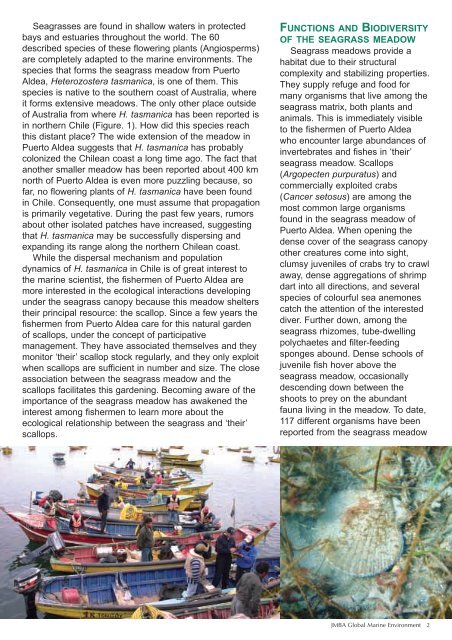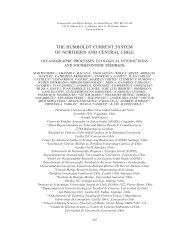Solitary seagrass meadow in Chile supports a unique ... - Bedim
Solitary seagrass meadow in Chile supports a unique ... - Bedim
Solitary seagrass meadow in Chile supports a unique ... - Bedim
- No tags were found...
You also want an ePaper? Increase the reach of your titles
YUMPU automatically turns print PDFs into web optimized ePapers that Google loves.
Seagrasses are found <strong>in</strong> shallow waters <strong>in</strong> protectedbays and estuaries throughout the world. The 60described species of these flower<strong>in</strong>g plants (Angiosperms)are completely adapted to the mar<strong>in</strong>e environments. Thespecies that forms the <strong>seagrass</strong> <strong>meadow</strong> from PuertoAldea, Heterozostera tasmanica, is one of them. Thisspecies is native to the southern coast of Australia, whereit forms extensive <strong>meadow</strong>s. The only other place outsideof Australia from where H. tasmanica has been reported is<strong>in</strong> northern <strong>Chile</strong> (Figure. 1). How did this species reachthis distant place? The wide extension of the <strong>meadow</strong> <strong>in</strong>Puerto Aldea suggests that H. tasmanica has probablycolonized the <strong>Chile</strong>an coast a long time ago. The fact thatanother smaller <strong>meadow</strong> has been reported about 400 kmnorth of Puerto Aldea is even more puzzl<strong>in</strong>g because, sofar, no flower<strong>in</strong>g plants of H. tasmanica have been found<strong>in</strong> <strong>Chile</strong>. Consequently, one must assume that propagationis primarily vegetative. Dur<strong>in</strong>g the past few years, rumorsabout other isolated patches have <strong>in</strong>creased, suggest<strong>in</strong>gthat H. tasmanica may be successfully dispers<strong>in</strong>g andexpand<strong>in</strong>g its range along the northern <strong>Chile</strong>an coast.While the dispersal mechanism and populationdynamics of H. tasmanica <strong>in</strong> <strong>Chile</strong> is of great <strong>in</strong>terest tothe mar<strong>in</strong>e scientist, the fishermen of Puerto Aldea aremore <strong>in</strong>terested <strong>in</strong> the ecological <strong>in</strong>teractions develop<strong>in</strong>gunder the <strong>seagrass</strong> canopy because this <strong>meadow</strong> shelterstheir pr<strong>in</strong>cipal resource: the scallop. S<strong>in</strong>ce a few years thefishermen from Puerto Aldea care for this natural gardenof scallops, under the concept of participativemanagement. They have associated themselves and theymonitor ‘their’ scallop stock regularly, and they only exploitwhen scallops are sufficient <strong>in</strong> number and size. The closeassociation between the <strong>seagrass</strong> <strong>meadow</strong> and thescallops facilitates this garden<strong>in</strong>g. Becom<strong>in</strong>g aware of theimportance of the <strong>seagrass</strong> <strong>meadow</strong> has awakened the<strong>in</strong>terest among fishermen to learn more about theecological relationship between the <strong>seagrass</strong> and ‘their’scallops.FUNCTIONS AND BIODIVERSITYOF THE SEAGRASS MEADOWSeagrass <strong>meadow</strong>s provide ahabitat due to their structuralcomplexity and stabiliz<strong>in</strong>g properties.They supply refuge and food formany organisms that live among the<strong>seagrass</strong> matrix, both plants andanimals. This is immediately visibleto the fishermen of Puerto Aldeawho encounter large abundances of<strong>in</strong>vertebrates and fishes <strong>in</strong> ‘their’<strong>seagrass</strong> <strong>meadow</strong>. Scallops(Argopecten purpuratus) andcommercially exploited crabs(Cancer setosus) are among themost common large organismsfound <strong>in</strong> the <strong>seagrass</strong> <strong>meadow</strong> ofPuerto Aldea. When open<strong>in</strong>g thedense cover of the <strong>seagrass</strong> canopyother creatures come <strong>in</strong>to sight,clumsy juveniles of crabs try to crawlaway, dense aggregations of shrimpdart <strong>in</strong>to all directions, and severalspecies of colourful sea anemonescatch the attention of the <strong>in</strong>teresteddiver. Further down, among the<strong>seagrass</strong> rhizomes, tube-dwell<strong>in</strong>gpolychaetes and filter-feed<strong>in</strong>gsponges abound. Dense schools ofjuvenile fish hover above the<strong>seagrass</strong> <strong>meadow</strong>, occasionallydescend<strong>in</strong>g down between theshoots to prey on the abundantfauna liv<strong>in</strong>g <strong>in</strong> the <strong>meadow</strong>. To date,117 different organisms have beenreported from the <strong>seagrass</strong> <strong>meadow</strong>JMBA Global Mar<strong>in</strong>e Environment 2










